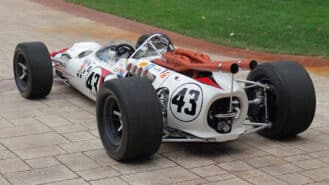
A ‘New Nige’? Foster focused on becoming next British IndyCar star
Louis Foster starts his IndyCar journey this weekend in St Petersburg – can he emulate other British heroes like Nigel Mansell and Dan Wheldon?
For many decades the Indianapolis Motor Speedway’s ‘Gasoline Alley’ was packed with cars during the month of May but in recent years the Indianapolis 500 has struggled to fill the field with the race’s traditional 33 starters. It’s one of many symptoms of Indycar racing’s long, steady decline over the last 15 years as the CART/IRL war wreaked havoc on the sport.
Today, TV ratings for the Indy 500 are smaller than the average NASCAR race draws and one-fifth what they were a quarter of a century ago. Your standard contemporary IndyCar race pulls a tiny national TV audience – fewer than 400,000 people – which is one-tenth the national TV ratings for CART races at the height of the old Indycar World Series 20 years ago when Nigel Mansell was doing battle in America.
Back before the CART/IRL split the series drew big crowds to all the races and the Indy 500 enjoyed a packed house of more than 350,000 on race day with almost as many people turning out for Pole Day two weeks before the 500. In fact, from the ‘60s through the mid-‘90s Pole Day was the world’s second largest sporting event behind only race day at the Speedway.
It’s interesting to reflect on some statistical data from 30 and 50 years ago. The 1984 Indy 500 attracted the largest number of entries the race has seen. No fewer than 117 cars were entered, this including all back-up or spare cars. Seventy-seven cars actually ran during practice or qualifying 30 years ago with 57 drivers taking to the track during the month.
In 1984, Robin Herd and his company March Engineering were dominating Indycar racing with no fewer than 29 Marches in that year’s field. March-Cosworth DFXs finished first through 14th in the 500 with Rick Mears scoring his second of four Indy wins driving a March for Penske Racing. There were two Lola-Cosworths in the field, driven by Mario Andretti and Danny Sullivan, plus an Eagle-Pontiac and a Primus-Cosworth. Two of the 29 Marches were powered by ‘stock block’ Buick V6 turbos.
Twenty years earlier, in 1964, there were just 61 entries for the Indy 500 but most of them practiced and no fewer than 13 car builders were represented in the starting field. This was the second year of the rear-engine revolution at Indianapolis and more than a third of the field – 12 cars – had their engines behind the driver.
Builders of the new-fangled cars were Lotus, Brabham, Mickey Thompson, Huffaker, Halibrand, Vollstedt and AJ Watson. Among the traditional 21 roadsters in the ’64 field were a dozen classic Watson-Offies and one of these, driven by AJ Foyt, won that year’s 500 chased home by 1959 and ’62 winner Rodger Ward aboard AJ Watson’s first rear-engined car.
Leaping forward 31 years to 1995, the last time CART’s teams and drivers raced at Indianapolis before Tony George created the IRL in ’96, the statistics are stunning. 104 cars were entered with 73 of them running some practice laps. No fewer than 96 driver/car combinations made practice runs and 71 qualifying attempts were made over the two weekends of qualifying.
That was also the year Penske Racing failed to qualify for the 500 after dominating the previous year’s race. It was a testament to how deeply competitive CART’s field was in those days and I well remember being swept along amid a frenetic scene in the pitlane at the end of the four qualifying days as a mob of newshounds surrounded Roger Penske to record his deep disappointment over his cars and drivers’ failure to make the race.
I also recall looking across the track and scanning the giant stretch of grandstands ringing the outside of turn four and the length of the front stretch, every inch jammed with humanity.
As I said at the beginning, for many years there were plenty of teams, cars and drivers as well as two arduous weeks of practice and qualifying to build interest and excitement in the 500 at the end of the month.
The entire month of May at Indianapolis was a major part of the American sports landscape but a long political war and a resulting dumbed down spec car formula has substantially reduced the importance of Indycar racing and the month of May over the last 20 years.

Hélio Castroneves, 2004 Pole Day
These days Pole Day draws only around 25,000 to 30,000 fans and there’s little or no national or international media coverage of what was once a big day. The Speedway is trying to bring back some of the old interest and excitement by adding an IndyCar race – called the Grand Prix of Indianapolis – on the infield road course next weekend and most everyone wishes them the best of luck with this latest experiment.
But if the powers-that-be at Indianapolis are going to find a long-term solution to Indycar racing’s malaise it surely lays in re-creating a modern version of the spirited competition among multiple car builders and radical new thinkers that drove the 500 for more than 90 years. In my opinion, they’re deluding themselves if they believe anything less will do the job.

Louis Foster starts his IndyCar journey this weekend in St Petersburg – can he emulate other British heroes like Nigel Mansell and Dan Wheldon?

Myles Rowe has rocketed through IndyCar's junior ladder with a story like no other – he tells James Elson why this upcoming year is more important than ever

Drive to Survive star Will Buxton has made the jump across the Atlantic to front Fox's new IndyCar coverage – he explained to James Elson why he thinks the championship is the most exciting series out there

Jackie Stewart's Lola-Ford IndyCar that failed laps from victory in the 1966 Indy 500 was the star lot in a 16-car auction, selling for $715,000